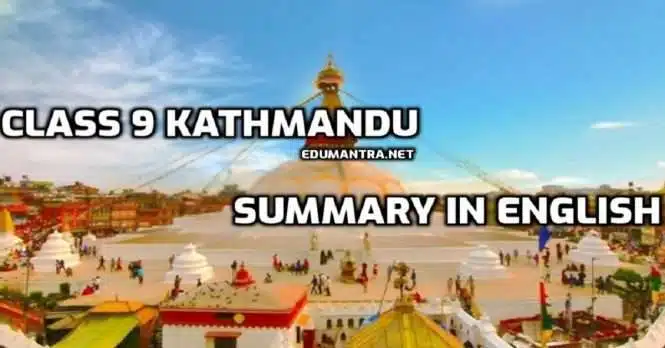
Kathmandu Chapter Class 9 Summary is written by experts. Go through and gain confidence. If you want to share your thoughts, please feel free to do so.
Kathmandu Chapter Class 9 Summary
In this section, Vikram Seth reminisces his first trip to Kathmandu in Nepal. He tells the reader about two temples of that city. One is the Pashupatinath temple of Hinduism and another is the Baudhnath Stupa of Buddhism. Inside, he found priests, hawkers, tourists, cows, monkeys, dogs and more.
There is a crowd of devotees and people push one another to make their way to the Lord. Only Hindus are allowed to enter this temple. Westerners struggle for permission to enter, but the policeman at the gate does not those let in. From his vantage point, one can see monkeys fighting each other through the window across from the Bagmati River. The author sees washerwomen at its banks.
On this day, ashes of a sacrifice are dumped into water, by people who devote their time and money to rise her up. The riverside is home to a small shrine for offerings which is submerged in the water below. A worshiper believes that the goddess inside will come out when all of the shrine comes out of the river.
While the Pashupatinath temple is busy, there is a sense of stillness at the Baudhnath stupa of the Buddhists. The author does not find crowds here, providing only a big white dome for visitors to admire and two small shrine buildings. The road surrounds it with small stores alongside. Many of these stores are owned by Tibetan immigrants.
Kathmandu is crowded and its narrow streets are jam-packed with individuals offering a variety of goods. The author exits the street and stumbles onto fruit sellers, flute sellers, hawkers of postcards, shops selling western cosmetics, films, chocolates, books, etc. It’s impossible to take it all in and the author returns home.
He comes back to his hotel. In a corner of the square near the hotel, he finds a man selling flutes. These flutes are made of bamboo. From time to time, the flute seller plays on this handcrafted instrument. The author likes how carefree he is and how easy-going it is to come away from there. In fact, the flute music always attracts him–the sound of the mellow tones reminiscent of what humanity has in common.
Kathmandu Chapter Class 9 Summary (2) :
On his way from China to India via Tibet, Vikram Seth reached Kathmandu in Nepal. In this extract, the narrator describes his visit to the two famous temples there – the Hindu temple of Pashupatinath and the Buddhist Boudhanath Stupa. After having a good sleep, Vikram Seth sets out with his companions to visit the temples settling on how they will enter and what they will do there.
Some locals were jostling with each other, trying to get the priest’s attention. A royal princess appeared in the temple. Some westerners claiming to be Hindu try to seek entry into the temple. Two monkeys chased each other. Priests, devotees, hawkers, dogs, pigeons, tourists -they all added to the confusion. He saw a cremation taking place on the banks of the Bagmati River, some women washing clothes while children were bathing in it. The river was being polluted as wilted flowers and old offerings were thrown into it.
In contrast to the noisy activity of the Hindu temple, Seth finds peace and quiet in Boudhanath Stupa. Though there are Tibetan shops nearby, no crowds gather at the stupa so it fades into the busy streets. It’s a safe haven amidst chaotic noise.
Describing Kathmandu, Seth writes that its streets are narrow, noisy and crowded with cars, bicycles and animals. The radio, traffic car horns and bikes can be heard from everywhere.
Despite the seriousness of his desire to get home, exhaustion and homesickness prompt Vikram Seth to buy an airline ticket. In a corner of the square near the hotel, an unassuming flute seller with casual approach captures his attention.
One of the aspects of the story is thinking about uniqueness and universality in music. It’s mentioned that flute sounds have similarities across different cultures, but it has its own signature sound in each. The sound of an instrument like a flute leaves a lasting impression on the persona and it brings him comfort when he returns home.
Want to Read More Check Below:-

Kathmandu- Passages for Comprehension
Kathmandu- Important Extra Questions- Short Answer Type
Kathmandu- Important Extra Questions- Long Answer Type
Kathmandu- Quick Review of the Chapter